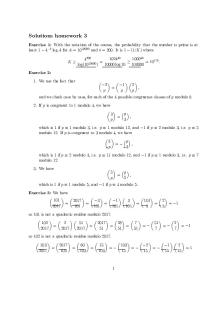2017-2018 Homework 0 - From the Fall 2017 course taught by Renato Feres PDF

| Title | 2017-2018 Homework 0 - From the Fall 2017 course taught by Renato Feres |
|---|---|
| Course | Probability |
| Institution | Washington University in St. Louis |
| Pages | 3 |
| File Size | 253.5 KB |
| File Type | |
| Total Downloads | 106 |
| Total Views | 149 |
Summary
From the Fall 2017 course taught by Renato Feres...
Description
Math493, Fall 2017 - HW 0 Renato Feres - Wash. U. This homework assignment won’t be collected, but do it as soon as possible. Its purpose is to have the R program up and running and getting a first taste of how to use it for basic math. 1. Installation. Choose an internet connected computer where you can install R. (The program is free and does not require any license to install.) To obtain and install it go to the R Project for Statistical Computing website, located at https://www.r-project.org/. On the left of the page click on the link CRAN under the heading “Download” and chose one of the many downloading sites. (Near the bottom of the page, under USA, you can find a Wash. U. site http://cran.wustl.edu/ ) These sites will take you to a page that looks in part like this:
From here follow the installation instructions. Once you have R successfully installed, open up the program. On my Mac, a window pops up that looks like this:
At the bottom of the window, notice the prompt symbol > indicating that R is ready to accept user input. Try writing something like > 1+1 then hit return. Hopefully, R is now ready to do work.
2. Back on the left column of the R project page, look for the link “Manuals” under the heading “Documentation.” You’ll find there several manuals for R. The first one, entitled An Introduction to R, is a useful general reference. There is plenty of information about R online for all sorts of needs. You may occasionally need to look up online or in the manual basic commands or procedures, although I will try to make the weekly assignments reasonably self-contained. (Assignments will typically contain a long tutorial part, which I suggest that you read carefully before working of the questions.) 3. I personally like a user interface for R called RStudio. This is not strictly needed for anything we are going to do, but while you are browsing around for R related resources check it out at http://www.rstudio.com. This is also a free program and easy to install on most computer platforms. RStudio is particularly convenient when installing packages or importing data. If you had prior experience with Matlab, RStudio will feel very familiar.
4. The first thing you can do with R is use it as an overgrown calculator. Try the following simple operations. Keep in mind that when assigning a value to a variable, say the value 2 to a variable you want to call a (something we need to do all the time), you can enter a=2 or a x=seq(from=0,to=4*pi,length.out=1000) > y=sin(x) > plot(x,y,type="l",main="graph of sin(x)") What happens if you leave out type="l" of the plot command? What happens if you choose another number, say 5, for the parameter length.out ? 6. What does the following accomplish: plot(cos,xlim=range(0,6*pi),type="l") 7. And the following? (This involves a user defined function.)
> f=function(x) x^2-2*sin(x)-cos(x/3) > plot(f,xlim=range(-2,2),type="l") ¡ ¢ 8. Draw a graph of the function f (x) =p 1 exp −x 2 /2 over the interval [−3,3]. 2π
Here’s a very short and incomplete list of elementary mathematical operations and functions in R:
Some useful cheat sheets: https://cran.r-project.org/doc/contrib/Short-refcard.pdf,
https://www.rstudio.com/wp-content/uploads/2016/10/r-cheat-sheet-3.pdf. 3...
Similar Free PDFs

A FALL FROM GRACE
- 1 Pages

ECON410 Syllabus Fall 2017
- 7 Pages

Chap3 - quiz - Fall 2017
- 3 Pages

Chap8 - quiz - Fall 2017
- 2 Pages
Popular Institutions
- Tinajero National High School - Annex
- Politeknik Caltex Riau
- Yokohama City University
- SGT University
- University of Al-Qadisiyah
- Divine Word College of Vigan
- Techniek College Rotterdam
- Universidade de Santiago
- Universiti Teknologi MARA Cawangan Johor Kampus Pasir Gudang
- Poltekkes Kemenkes Yogyakarta
- Baguio City National High School
- Colegio san marcos
- preparatoria uno
- Centro de Bachillerato Tecnológico Industrial y de Servicios No. 107
- Dalian Maritime University
- Quang Trung Secondary School
- Colegio Tecnológico en Informática
- Corporación Regional de Educación Superior
- Grupo CEDVA
- Dar Al Uloom University
- Centro de Estudios Preuniversitarios de la Universidad Nacional de Ingeniería
- 上智大学
- Aakash International School, Nuna Majara
- San Felipe Neri Catholic School
- Kang Chiao International School - New Taipei City
- Misamis Occidental National High School
- Institución Educativa Escuela Normal Juan Ladrilleros
- Kolehiyo ng Pantukan
- Batanes State College
- Instituto Continental
- Sekolah Menengah Kejuruan Kesehatan Kaltara (Tarakan)
- Colegio de La Inmaculada Concepcion - Cebu











